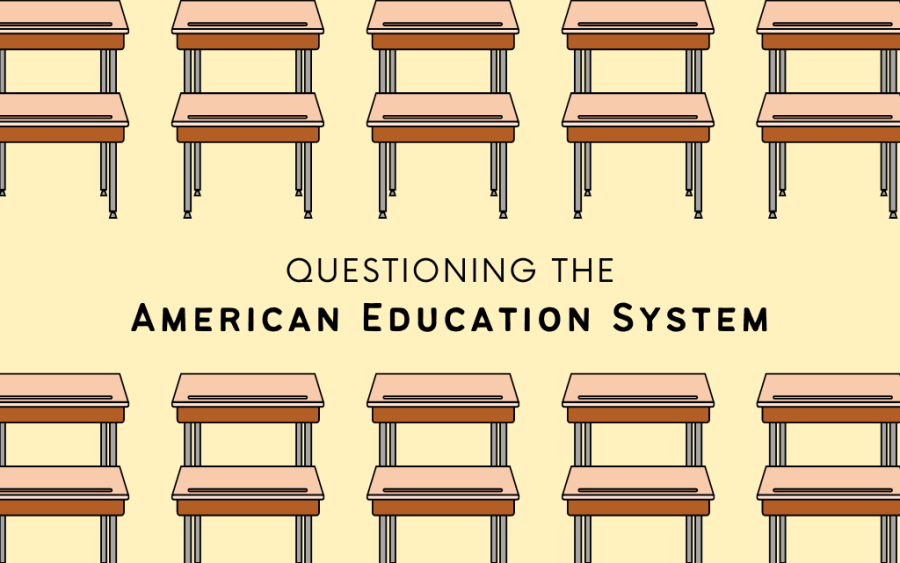Students Scrutinize American School Systems
Rows of desks signify the rigid structure of the American education system, which is supposedly outdated by 200 years. The main drawbacks of the current system are its inability to effectively teach relevant information.
May 27, 2023
In the 1950s, the United States Air Force was suffering major losses of up to 17 airmen in one day. The military claimed it was the pilots’ fault, but pilots instead blamed the aircraft. When it was tested by technicians, however, everything was working as intended. It turned out that cockpit designers only accounted for the average 30% of men. Eventually, they realized that the pilot’s seat couldn’t be standardized, but instead had to be adjustable to fit individual needs. After this policy was adopted, fatal crashes decreased and pilot performance soared.
This rigid layout parallels the inflexibility of the American education system according to students, even as technology evolves and industry needs fluctuate. Westwood Student Press asked the student body to describe their opinions on this topic and what could potentially be done about it.
When asked “How stressed are you due to school? (On a scale of 1 to 10)”, 76.9% of survey respondents said 7 or higher. This is a raw example of how school affects students’ stress levels, which may ultimately negatively impact their health.
An article by Kendra Cherry, MS, shows that prolonged stress can lead to anxiety disorders, autoimmune diseases, decreased immunity, depression, diabetes, heart disease, insomnia, obesity, and even post-traumatic stress disorder. Cherry also lists common symptoms of prolonged stress, including anxiety, difficulty concentrating, disorganized thoughts, headaches, indigestion, irritability, mood changes, and trouble sleeping. This could explain some of the stereotypical moods and behavior associated with adolescents, such as moodiness, tiredness, and general irritability.
Next in the survey were the outcomes of this stress, focusing mainly on the results of poor mental health. Student Press asked, “Have you ever experienced any major medical or mental events that have been caused by the pressures of school?” 60.7% of students reported some form of depression and 58.9% developed an anxiety disorder. Out of 78 students, 15 reported self harm, 4 reported a suicide attempt, and 5 reported hospitalization. These results show the severity of the issue, and the serious consequences associated with it.
If they felt comfortable, students were invited to share what caused these events. A massive 71% of respondents said that it was the result of putting work above personal health. This overwhelming number shows how students who may not have immediate healthy coping mechanisms resort to sacrificing sleep, food, water, and breaks. In this nature of foregoing personal needs for the end result, students were asked if they believe that the education system is outdated. There were four mixed responses, saying that the system is outdated “somewhat,” or that “some aspects are.” An overwhelming 80.8% of students responded, “yes.”
The current American education system uses a factory-model classroom, which was designed to prepare youth for a 19th century industrializing society. In a world that is post-COVID, with changes in market trends, supply and demand, and the amount of remote work, the current system just can’t keep up.
“It’s not that [the current education system is] particularly outdated, it’s that it doesn’t cover all scenarios for students with needs,” an anonymous survey respondent said. “I, and about a third of the school, [have] ADD, ADHD, or have been diagnosed with something similar.”
This is not an uncommon occurrence. About 6.1 million American children have been diagnosed with ADHD, according to the Centers for Disease Control and Prevention. In order for these students to be given an equal chance to succeed, the education system has to adjust, provide proper accommodations, and update as children’s needs fluctuate between school years.
“The way teachers and staff here at Westwood tend to handle such issues is to tell students to just turn their work in on time, and to make a binder, make reminders, and so on. I personally forget to check my calendars, and forget to set my alarms. The main issue is, the school doesn’t address this. It feels like they ignore those student’s needs, and let them work themselves out,” an anonymous student said.
When asked what should be incorporated into the school system, 87.2% of students wanted the education system to better prepare students for the real world.
“I don’t need to know how to calculate the surface area of a cone. I need to learn about taxes and how to apply for a job,” an anonymous student said.
Three individual students brought up the potential benefits of the four-day work week, which has already been adopted by large companies. According to CNBC, ever since introducing this policy, productivity and job applications increased, and absenteeism decreased.
“I know [that] some kids need to study for hours and hours every night to even pass upcoming exams,” an anonymous student said. “I’ve found that I can get by, or even excel with just the lectures in class. The school could add certain types of classes that have reduced homework, or increased homework based on the kid’s needs. This way, the school can best set the student up for success.”
Indeed reports that not only are the 9 main teaching methods diverse, they’re also extremely important. The report also points out that the way teachers teach students, and the content they convey, is an essential part of what the education system should provide.
Then, Student Press asked students “Would you say that American public education is currently/has prepared you for adulthood?” 87.2% of students surveyed said that American public education did not prepare them for adulthood.
According to an article by BigThink, only 17 states require high school students to take a personal finance class. Most schools may not be teaching relevant information that students may need to use out in the real world.
“Depending on the student, it can teach productivity and organization or how to master procrastination,” an anonymous student said.
According to one student, the administration is not encouraging a variety of assignments and different learning styles.
“I have little motivation for doing well in school, and I never get the vibe from the administration that they really want us to do well/be successful,” the student said. “If they did, they would do a better job [of] supplying the various different needs that different students require to be successful.”
Reading Rockets shows the importance of these kinds of accommodations, saying that it’s an important gateway to providing students with equal access to learning. Another important element is the inclusion of different learning styles, to address different needs, which an article from HeyTeach says is the key to the student’s engagement.
Some students believed that having their voices heard was beneficial to the improvement of the education situation.
“I think that asking students themselves how they feel about the education system is a great idea,” an anonymous student said. “They’re the ones directly affected. Of course, that only applies if these kinds of surveys actually lead to change.”
The disappointing tone isn’t unfounded. Changing things in schools is unexpectedly difficult, according to an article from NAIS. A main takeaway from the article was that test scores are merely symptoms to an entirely different underlying problem.
Through the survey, the student body expressed their resignation with inaction and ineffective solutions. Some students supported social, cultural, and economic changes to the school system.
“[We need to include] home care classes (teach [students] to cook, clean, and take care of ourselves and others) since many seniors do not feel ready for the real world after high school,” an anonymous student said.
“[I feel] somewhat [prepared for adulthood], in the sense that [through school] I’m learning how to work with others, deal with stress, and build good study/work habits,” Ishira Limaye ’25 said. “It hasn’t prepared me for things like taxes, how to take out a mortgage, how to navigate looking for a career, how to change a tire, how to cook (we have a cooking class but it has prerequisites), how to fix basic plumbing issues, etc. You can learn some of these things at school, but you have to take a specific class for them.”
Ultimately, this data suggests that the system is outdated. If 80% of students agree, maybe it’s time for a more modern reformation of education. Based on these responses, America seemingly has an ineffective system, one that seems to be producing resounding mental illnesses, unnecessary stress, and ill-equipped adults.
These students’ voices shared a lot of compelling information about how the American education system has felt to them. Some have experienced negative health results, some have only felt forced into a system that doesn’t accommodate them, and still others feel unprepared for adulthood. If Americans expect to prepare the younger generations for times ahead of themselves, then maybe the country should shift towards stimulating an environment that treats learning like an experience, not a performance.
Society has upgraded since the first iPhone, the Benz Patent Motor Car, and the original printing press. Maybe it’s time education is updated too.



